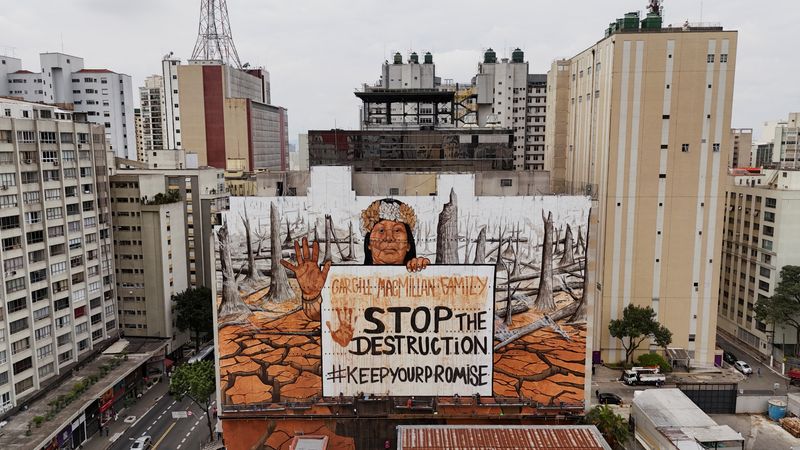By Amanda Perobelli and Lais Morais
SAO PAULO (Reuters) – Brazilian street artist Mundano’s latest work uses ash from forest fires and mud from floods in Brazil to create a giant mural calling for an end to deforestation.
The mural was inaugurated on Wednesday on the side of an 11-storey building in the center of Latin America’s largest city, adding a colorful and sharp message to Sao Paulo’s rich graffiti collection.
The 48-by-30-meter work depicts tree stumps from a burned forest and the face of an indigenous woman holding a sign in English that reads: “Stop the Destruction.”
The mural is painted with colors made with the ash from forest fires in Brazil, including the Amazon (NASDAQ:), where parts of the rainforest have been destroyed by recent fires in the worst drought on record. Mundano told Reuters he also used mud from massive floods in southern Brazil earlier this year.
The woman in the mural is indigenous leader Alessandra Korap Munduruku, who led a successful campaign to prevent multinational mining companies from exploring her tribe’s ancestral lands in the Amazon, for which she won the 2023 Goldman Environmental Prize.
Mundano said his mural is intended as a protest against companies that have pushed the agricultural frontier into the Amazon rainforest with large-scale soy plantations and cattle ranching for beef, making Brazil one of the world’s biggest food exporters.
The mural specifically targets American grain trader Cargill Inc., temporarily painting the names of Cargill family members on the mural. Mundano said he wanted the Cargill family, which owns the company, to keep its word that they would remove deforestation from the supply chain.
Cargill has pledged to eliminate deforestation from its key crop supply chain in Brazil by 2025 and from the South American soy chain by 2030.
“We are on track to deliver on that promise,” Cargill said in a statement, adding that the mural was based on incorrect information.
“The fact is that Cargill has accelerated its commitment to eliminate deforestation and land conversion from our direct and indirect soy, corn, wheat and cotton supply chains in Brazil, Argentina and Uruguay by 2025,” the statement said.
Along with ash and mud, Mundano used clay from indigenous reserves who have struggled to have their land rights recognized, often in conflicts with farmers. The mural also features paint made from urucum, a red tropical fruit used as body paint by Amazonian tribes.
“This may be the largest mural ever created with natural pigments,” Mundano said as he mixed the paint for the work.

“The names we write here are of billionaires who still live in a model based on the destruction of ecosystem biomes and contributing to the climate crisis,” he said.
The mural is a collaboration with the nonprofit Stand.earth, which funded the project.


